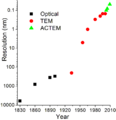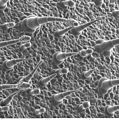Microscope facts for kids

A microscope is a scientific instrument. It makes small objects look larger. This lets people see the small things. People who use microscopes frequently in their jobs include doctors and scientists. Students in science classes such as biology also use microscopes to study small things. The earliest microscopes had only one lens and are called simple microscopes. Compound microscopes have at least two lenses. In a compound microscope, the lens closer to the eye is called the eyepiece. The lens at the other end is called the objective. The lenses multiply up, so a 10x eyepiece and a 40x objective together give 400x magnification.
Microscopes make things seem larger than they are, to about 1000 times larger. This is much stronger than a magnifying glass which works as a simple microscope.
Types of microscopes
There are many types of microscopes. The most common kind of microscope is the compound light microscope. In a compound light microscope, the object is illuminated: light is thrown on it. The user looks at the image formed by the object. Light passes through two lenses and makes the image bigger.
The second most common kind are a few kinds of electron microscopes. Transmission electron microscopes (TEMs) fire cathode rays into the object being looked at. This carries information about how the object looks into a magnetic "lens". The image is then magnified onto a television screen. Scanning electron microscopes also fire electrons at the object, but in a single beam. These lose their power when they strike the object, and the loss of power results in something else being generated—usually an X-ray. This is sensed and magnified onto a screen. Scanning tunneling microscopes were invented in 1984.
A fluorescence microscope is a special kind of light microscope. In 2014, the Nobel Prize in Chemistry was awarded to Eric Betzig, William Moerner, and Stefan Hell for "the development of super-resolved fluorescence microscopy". The citation says it brings "optical microscopy into the nanodimension".
Images for kids
-
18th-century microscopes from the Musée des Arts et Métiers, Paris
-
Electron microscope constructed by Ernst Ruska in 1933
See also
 In Spanish: Microscopio para niños
In Spanish: Microscopio para niños







